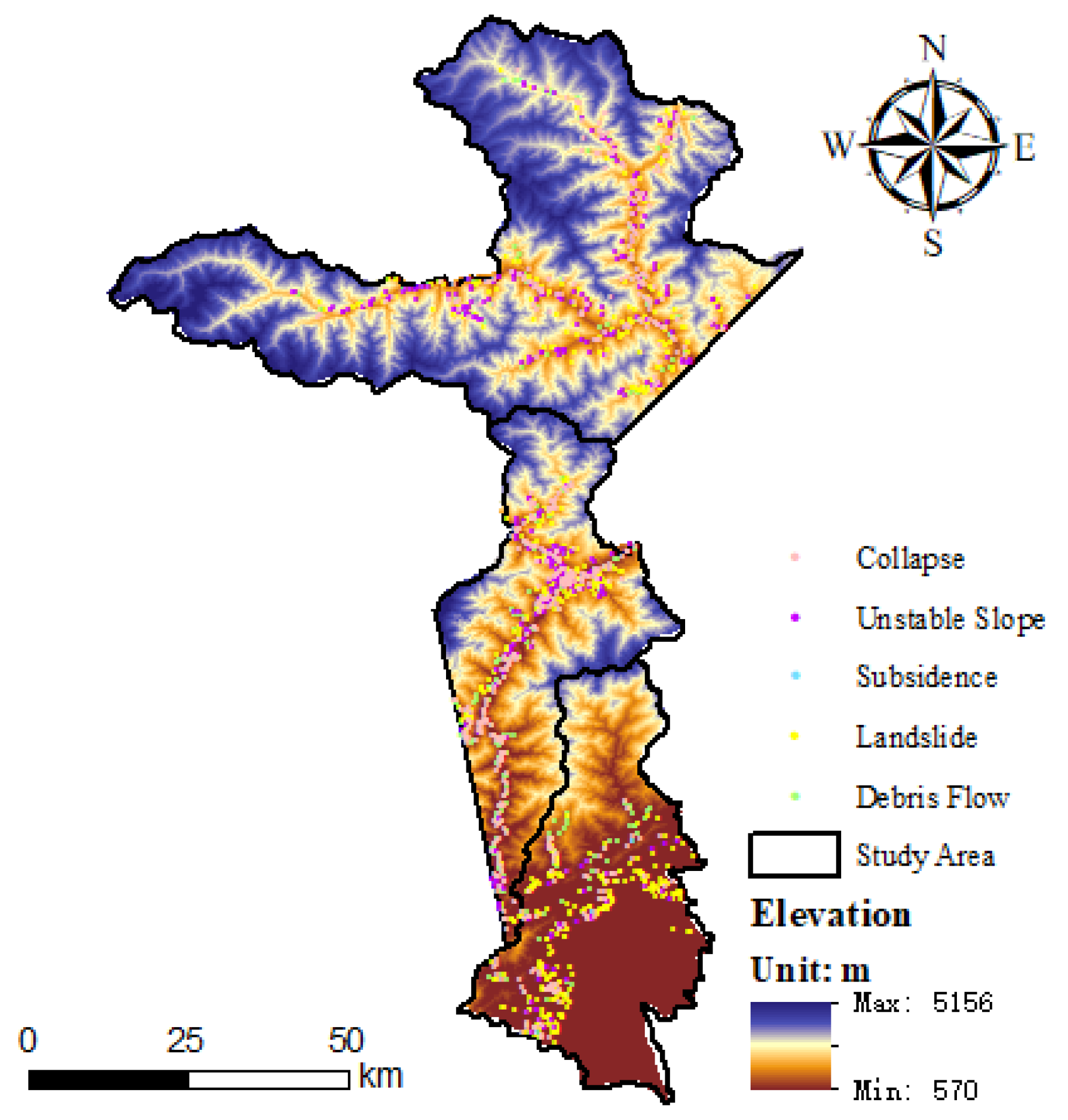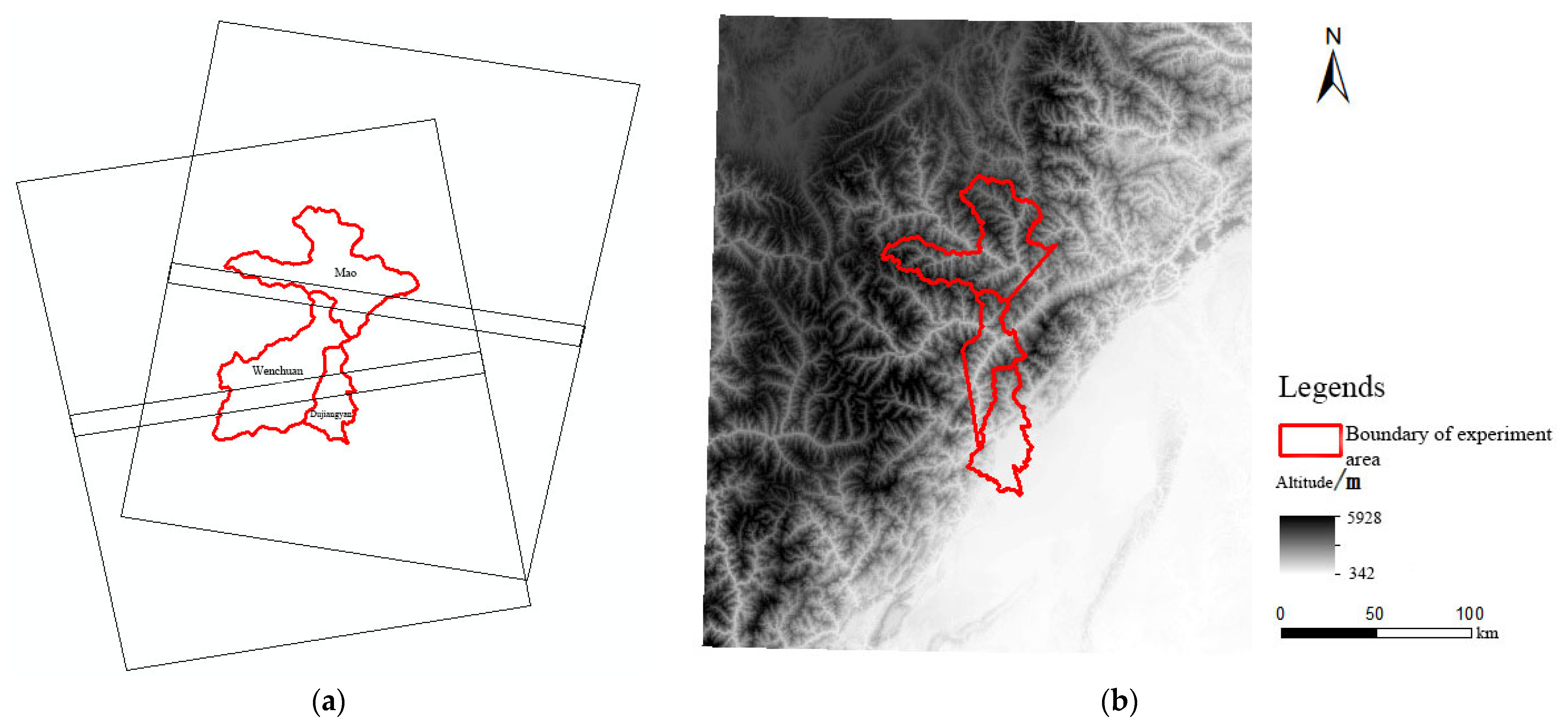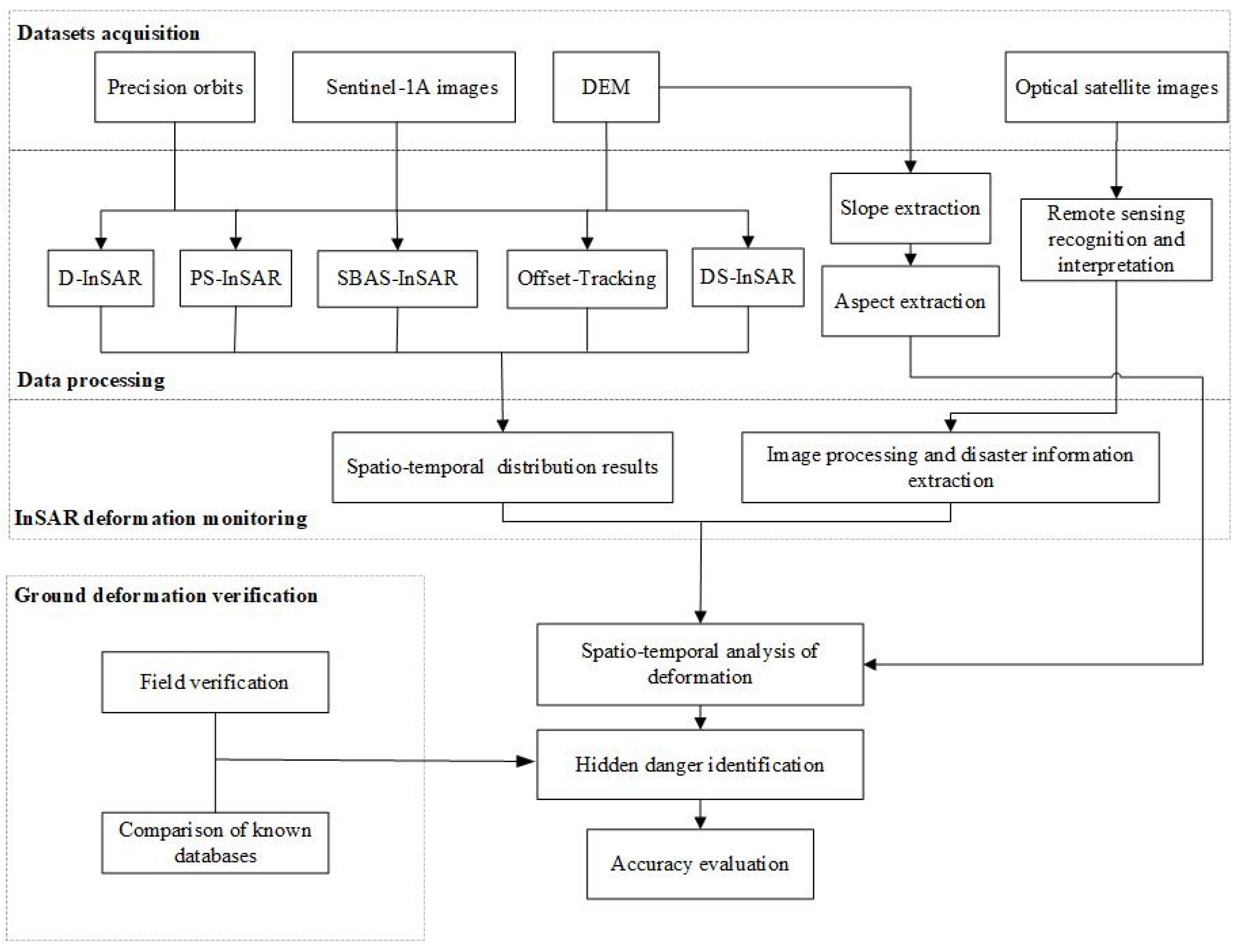Monitoring Potential Geological Hazards with Different InSAR Algorithms: The Case of Western Sichuan
Abstract
:1. Introduction
2. Study Area
3. Test Datasets and Methods
3.1. Test Datasets
3.1.1. Optical Satellite Image Data
3.1.2. SAR Image Related Data
3.2. Methods
3.2.1. D-InSAR
3.2.2. Offset-Tracking
3.2.3. PS-InSAR
3.2.4. SBAS-InSAR
3.2.5. DS-InSAR
4. Results
4.1. Monitoring Results of Potential Geological Hazards
4.2. Accuracy Evaluation
5. Discussion
5.1. Causes of the Areas Affected by “Geological Hazards”
5.2. Applicability of Different InSAR Algorithms
6. Conclusions
- (1)
- In the elevation range below 1000 m, the vegetation coverage is low and the terrain slope is slow. There are very few hidden points of geological disasters extracted by various InSAR methods, but DS-InSAR can extract more deformation feature points compared to the other four InSAR methods and has a better monitoring effect.
- (2)
- In the elevation range of 1000–3500 m, the vegetation coverage is high and the terrain slope is steep. SBAS-InSAR and DS-InSAR can extract more deformation feature points and potential geological hazard points, which has a good monitoring effect.
- (3)
- In the elevation range above 3500 m, the vegetation coverage is high and the terrain slope is steep. By comparing and analyzing the number of deformation feature points extracted by different algorithms in this area, it is concluded that SBAS-InSAR and DS-InSAR have relatively good applicability in the study area with an elevation of more than 3500 m.
Author Contributions
Funding
Acknowledgments
Conflicts of Interest
References
- Angeli, M.-G.; Pasuto, A.; Silvano, S. A critical review of landslide monitoring experiences. Eng. Geol. 2000, 55, 133–147. [Google Scholar] [CrossRef]
- Li, C.; Shi, X.; Tang, L.; Qiu, H.; Tan, M. Real-Time Geological Disaster Monitoring with Deformation Parameters Auto-Detection Technique. In Second International Conference on Earth Observation for Global Changes; International Society for Optics and Photonics: Bellingham, WA, USA, 2009; Volume 7471, p. 74711. [Google Scholar]
- Huang, F.; Wu, P.; Ziggah, Y. GPS Monitoring Landslide Deformation Signal Processing using Time-series Model. Int. J. Signal Process. Image Process. Pattern Recognit. 2016, 9, 321–332. [Google Scholar] [CrossRef]
- Li, S.; Wang, Z.; Yuan, L.; Li, X.; Huang, Y.; Guo, R. Mechanism of land subsidence of plateau lakeside Kunming city cluster (China) by MT-InSAR and leveling survey. J. Coast. Res. 2020, 115, 666–675. [Google Scholar] [CrossRef]
- Carminati, E.; Martinelli, G. Subsidence rates in the Po Plain, northern Italy: The relative impact of natural and anthropogenic causation. Eng. Geol. 2002, 66, 241–255. [Google Scholar] [CrossRef]
- Hu, B.; Chen, J.; Zhang, X. Monitoring the Land Subsidence Area in a Coastal Urban Area with InSAR and GNSS. Sensors 2019, 19, 3181. [Google Scholar] [CrossRef] [Green Version]
- Kang, Y.; Lu, Z.; Zhao, C.; Xu, Y.; Kim, J.-W.; Gallegos, A.J. InSAR monitoring of creeping landslides in mountainous regions: A case study in Eldorado National Forest, California. Remote Sens. Environ. 2021, 258, 112400. [Google Scholar] [CrossRef]
- Zhu, K.; Xu, P.; Cao, C.; Zheng, L.; Liu, Y.; Dong, X. Preliminary identification of geological hazards from Songpinggou to Feihong in Mao county along the Minjiang river using SBAS-InSAR technique integrated multiple spatial analysis methods. Sustainability 2021, 13, 1017. [Google Scholar] [CrossRef]
- Massonnet, D.; Rossi, M.; Carmona, C.; Adragna, F.; Peltzer, G.; Feigl, K.; Rabaute, T. The displacement field of the Landers earth-quake mapped by radar interferometry. Nature 1993, 364, 138–142. [Google Scholar] [CrossRef]
- Shi, X.; Zhang, L.; Balz, T.; Liao, M. Landslide deformation monitoring using point-like target offset tracking with multi-mode high-resolution TerraSAR-X data. ISPRS-J. Photogramm. Remote Sens. 2015, 105, 128–140. [Google Scholar] [CrossRef]
- Lee, H.; Liu J, G. Analysis of topographic decorrelation in SAR interferometry using ratio coherence imagery. IEEE Trans. Geosci. Remote Sensing. 2001, 39, 223–232. [Google Scholar]
- Zhang, L.; Ding, X.; Lu, Z.; Jung, H.-S.; Hu, J.; Feng, G. A Novel Multitemporal InSAR Model for Joint Estimation of Deformation Rates and Orbital Errors. IEEE Trans. Geosci. Remote Sens. 2013, 52, 3529–3540. [Google Scholar] [CrossRef] [Green Version]
- Zhao, C.; Kang, Y.; Zhang, Q.; Lu, Z.; Li, B. Landslide Identification and Monitoring along the Jinsha River Catchment (Wudongde Reservoir Area), China, Using the InSAR Method. Remote Sens. 2018, 10, 993. [Google Scholar] [CrossRef] [Green Version]
- Yang, C.-S.; Zhang, Q.; Xu, Q.; Zhao, C.-Y.; Peng, J.-B.; Ji, L.-Y. Complex Deformation Monitoring over the Linfen–Yuncheng Basin (China) with Time Series InSAR Technology. Remote Sens. 2016, 8, 284. [Google Scholar] [CrossRef] [Green Version]
- Yang, C.-S.; Zhang, Q.; Zhao, C.-Y.; Wang, Q.-L.; Ji, L.-Y. Monitoring land subsidence and fault deformation using the small baseline subset InSAR technique: A case study in the Datong Basin, China. J. Geodyn. 2014, 75, 34–40. [Google Scholar] [CrossRef]
- Ferretti, A.; Prati, C.; Rocca, F. Permanent scatterers in SAR interferometry. IEEE Trans. Geosci. Remote Sens. 2001, 39, 8–20. [Google Scholar] [CrossRef]
- Berardino, P.; Fornaro, G.; Lanari, R.; Sansosti, E. A new algorithm for surface deformation monitoring based on small baseline differential SAR interferograms. IEEE Trans. Geosci. Remote Sens. 2002, 40, 2375–2383. [Google Scholar] [CrossRef] [Green Version]
- Zhao, R.; Li, Z.W.; Feng, G.C.; Wang, Q.J.; Hu, J. Monitoring surface deformation over permafrost with an improved SBAS-InSAR algorithm: With emphasis on climatic factors modeling. Remote Sens. Environ. 2016, 184, 276–287. [Google Scholar] [CrossRef]
- Hooper, A. A multi-temporal InSAR method incorporating both persistent scatterer and small baseline approaches. Geophys. Res. Lett. 2008, 35. [Google Scholar] [CrossRef] [Green Version]
- Zhang, L.; Ding, X.; Lu, Z. Ground settlement monitoring based on temporarily coherent points between two SAR acquisitions. ISPRS J. Photogramm. Remote Sens. 2011, 66, 146–152. [Google Scholar] [CrossRef]
- Chen, X.; Tessari, G.; Fabris, M.; Achilli, V.; Floris, M. Comparison between PS and SBAS InSAR Techniques in Monitoring Shallow Landslides. In Workshop on World Landslide Forum; Springer: Cham, Switzerland, 2021; pp. 155–161. [Google Scholar]
- Dong, J.; Gong, J.; Liao, M.; Zhang, L.; Shi, X.; Liu, Y. Landslides analysis in western moutainous areas of China using Distributed Scatterers based InSAR. In Proceedings of the 2016 IEEE International Geoscience and Remote Sensing Symposium (IGARSS), Beijing, China, 10–15 July 2016; pp. 5773–5776. [Google Scholar]
- Mazzotti, S.; Lambert, A.; Van Der Kooij, M.; Mainville, A. Impact of anthropogenic subsidence on relative sea-level rise in the Fraser River delta. Geology 2009, 37, 771–774. [Google Scholar] [CrossRef]
- Burgmann, R.; Hilley, G.; Ferretti, A.; Novali, F. Resolving vertical tectonics in the San Francisco Bay Area from permanent scatterer InSAR and GPS analysis. Geology 2006, 34, 221. [Google Scholar] [CrossRef] [Green Version]
- Parcharidis, I.; Kourkouli, P.; Karymbalis, E.; Foumelis, M.; Karathanassi, V. Time Series Synthetic Aperture Radar Interferometry for Ground Deformation Monitoring over a Small Scale Tectonically Active Deltaic Environment (Mornos, Central Greece). J. Coast. Res. 2011, 29, 325–338. [Google Scholar] [CrossRef] [Green Version]
- Sun, W.; Tian, Y.; Mu, X.; Zhai, J.; Gao, P.; Zhao, G. Loess Landslide Inventory Map Based on GF-1 Satellite Imagery. Remote Sens. 2017, 9, 314. [Google Scholar] [CrossRef] [Green Version]
- Wang, G.; Xie, M.; Chai, X.; Wang, L.; Dong, C. D-InSAR-based landslide location and monitoring at Wudongde hydropower reservoir in China. Environ. Earth Sci. 2013, 69, 2763–2777. [Google Scholar] [CrossRef]
- Meng, Q.; Li, W.; Raspini, F.; Xu, Q.; Peng, Y.; Ju, Y.; Zheng, Y.; Casagli, N. Time-series analysis of the evolution of large-scale loess landslides using InSAR and UAV photogrammetry techniques: A case study in Hongheyan, Gansu Province, Northwest China. Landslides 2021, 18, 251–265. [Google Scholar] [CrossRef]
- Cascini, L.; Fornaro, G.; Peduto, D. Advanced low-and full-resolution DInSAR map generation for slow-moving landslide analysis at different scales. Eng. Geol. 2010, 112, 29–42. [Google Scholar] [CrossRef]
- Wang, C.; Mao, X.; Wang, Q. Landslide displacement monitoring by a fully polarimetric SAR offset tracking method. Remote Sens. 2016, 8, 624. [Google Scholar] [CrossRef] [Green Version]
- Xu, X.; Ma, C.; Lian, D.; Zhao, D. Inversion and Analysis of Mining Subsidence by Integrating DInSAR, Offset Tracking, and PIM Technology. J. Sens. 2020, 2020, 4136837. [Google Scholar] [CrossRef]
- Ferretti, A.; Prati, C.; Rocca, F. Nonlinear subsidence rate estimation using permanent scatterers in differential SAR interferometry. IEEE Trans. Geosci. Remote Sens. 2000, 38, 2202–2212. [Google Scholar] [CrossRef] [Green Version]
- Beladam, O.; Balz, T.; Mohamadi, B.; Abdalhak, M. Using ps-insar with sentinel-1 images for deformation monitoring in northeast Algeria. Geosciences 2019, 9, 315. [Google Scholar] [CrossRef] [Green Version]
- Greif, V.; Vlcko, J. Monitoring of post-failure landslide deformation by the PS-InSAR technique at Lubietova in Central Slovakia. Environ. Earth Sci. 2012, 66, 1585–1595. [Google Scholar] [CrossRef]
- Ferretti, A.; Prati, C.; Rocca, F. Analysis of permanent scatterers in SAR interferometry. In Proceedings of the IGARSS 2000—IEEE International Geoscience and Remote Sensing Symposium, Honolulu, HI, USA, 24–28 July 2000. [Google Scholar]
- Sousa, J.J.; Ruiz, A.M.; Hanssen, R.F.; Bastos, L.; Gil, A.J.; Galindo-Zaldívar, J.; de Galdeano, C.S. PS-InSAR processing method-ologies in the detection of field surface deformation—Study of the Granada basin (Central Betic Cordilleras, southern Spain). J. Geodyn. 2010, 49, 181–189. [Google Scholar] [CrossRef]
- Hooper, A.; Segall, P.; Zebker, H. Persistent scatterer interferometric synthetic aperture radar for crustal deformation analysis. J. Geophys. Res. 2007, 112, 1–21. [Google Scholar]
- Liu, Y.; Fan, H.; Wang, L.; Zhuang, H. Monitoring of surface deformation in a low coherence area using distributed scatterers InSAR: Case study in the Xiaolangdi Basin of the Yellow River, China. Bull. Eng. Geol. Environ. 2021, 80, 25–39. [Google Scholar] [CrossRef]
- Goel, K.; Adam, N. A distributed scatterer interferometry approach for precision monitoring of known surface deformation phenomena. IEEE Trans. Geosci. Remote Sens. 2013, 52, 5454–5468. [Google Scholar] [CrossRef]
- Liu, G.; Zbigniew, P.; Stefano, S.; Benni, T.; Wu, L.; Fan, J.; Joaquim, J.S. Land Surface Displacement Geohazards Monitoring Using Multi-temporal InSAR Techniques. J. Geod. Geoinf. Sci. 2021, 4, 77. [Google Scholar]
- Li, T.; Zhang, H.; Fan, H.; Zheng, C.; Liu, J. Position inversion of goafs in deep coal seams based on DS-InSAR data and the probability integral methods. Remote Sens. 2021, 13, 2898. [Google Scholar] [CrossRef]
- Ferretti, A.; Fumagalli, A.; Novali, F.; Prati, C.; Rocca, F.; Rucci, A. A New Algorithm for Processing Interferometric Data-Stacks: SqueeSAR. IEEE Trans. Geosci. Remote Sens. 2011, 49, 3460–3470. [Google Scholar] [CrossRef]








| Satellite System Parameters | Description |
|---|---|
| Launch date | April 2014 |
| Frequency | 5.4 GHz |
| Band | C |
| Revisit period | 12 d |
| Shooting mode | IW |
| Resolution ratio (m) | 5 × 20 |
| Width of cloth | 250 km |
| Polarization mode | VV |
| No. | Repetitive | Non-Repetitive | Total | |
|---|---|---|---|---|
| Methods | ||||
| D-InSAR | 3 | 2 | 5 | |
| SBAS-InSAR | 12 | 12 | 24 | |
| PS-InSAR | 9 | 3 | 12 | |
| DS-InSAR | 16 | 16 | 32 | |
| Offset-Tracking | 0 | 0 | 0 | |
| Types | No. Potential Geological Hazards | Total | ||
|---|---|---|---|---|
| Dujiangyan | Wenchuan | Mao | ||
| Landslide | 2 | 14 (7) | 29 (4) | 45 (11) |
| Collapse | 0 | 2 | 1 | 3 |
| Debris flow | 1 | 0 | 0 | 1 |
| Total | 3 | 16 (7) | 30 (4) | 49 (11) |
| Algorithms | No. Potential Disaster Points | Total | ||
|---|---|---|---|---|
| <1000 m | 1000–3500 m | >3500 m | ||
| D-InSAR | 1 | 4 | 0 | 5 |
| SBAS-InSAR | 0 | 24 | 0 | 24 |
| PS-InSAR | 0 | 12 | 0 | 12 |
| DS-InSAR | 2 | 30 | 0 | 32 |
| Offset-Tracking | 0 | 0 | 0 | 0 |
| Values | Field Verification | Correct Number | Accuracy (%) | |
|---|---|---|---|---|
| Types | ||||
| Deformation areas | 13 | 9 | 69.23 | |
| New potential hazards | 11 | 7 | 63.64 | |
| Algorithms | No. Deformation Feature Points | Total | ||
|---|---|---|---|---|
| <1000 m | 1000–3500 m | >3500 m | ||
| PS-InSAR | 59,981 | 12,165 | 19,212 | 91,358 |
| SBAS-InSAR | 74,090 | 137,316 | 90,452 | 301,858 |
| DS-InSAR | 182,960 | 80,430 | 111,335 | 374,725 |
Publisher’s Note: MDPI stays neutral with regard to jurisdictional claims in published maps and institutional affiliations. |
© 2022 by the authors. Licensee MDPI, Basel, Switzerland. This article is an open access article distributed under the terms and conditions of the Creative Commons Attribution (CC BY) license (https://creativecommons.org/licenses/by/4.0/).
Share and Cite
Zheng, Z.; Xie, C.; He, Y.; Zhu, M.; Huang, W.; Shao, T. Monitoring Potential Geological Hazards with Different InSAR Algorithms: The Case of Western Sichuan. Remote Sens. 2022, 14, 2049. https://doi.org/10.3390/rs14092049
Zheng Z, Xie C, He Y, Zhu M, Huang W, Shao T. Monitoring Potential Geological Hazards with Different InSAR Algorithms: The Case of Western Sichuan. Remote Sensing. 2022; 14(9):2049. https://doi.org/10.3390/rs14092049
Chicago/Turabian StyleZheng, Zezhong, Chuhang Xie, Yong He, Mingcang Zhu, Weifeng Huang, and Tianming Shao. 2022. "Monitoring Potential Geological Hazards with Different InSAR Algorithms: The Case of Western Sichuan" Remote Sensing 14, no. 9: 2049. https://doi.org/10.3390/rs14092049





